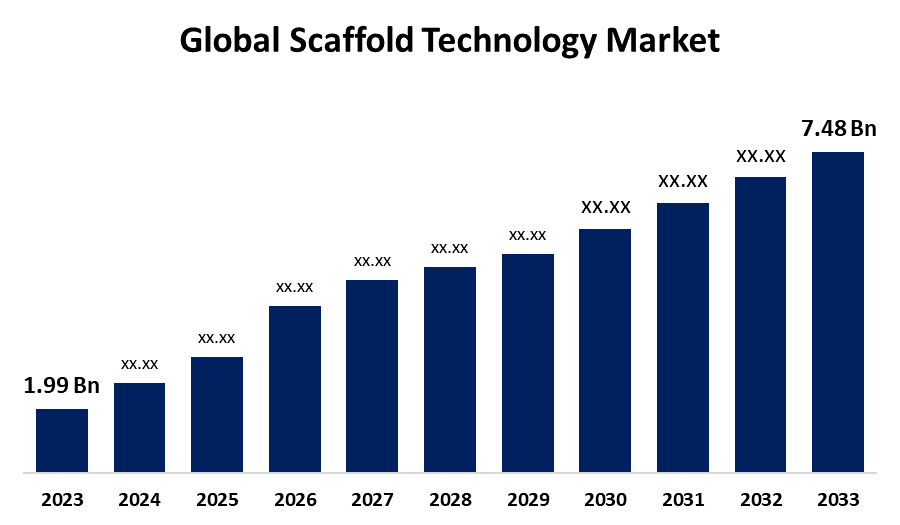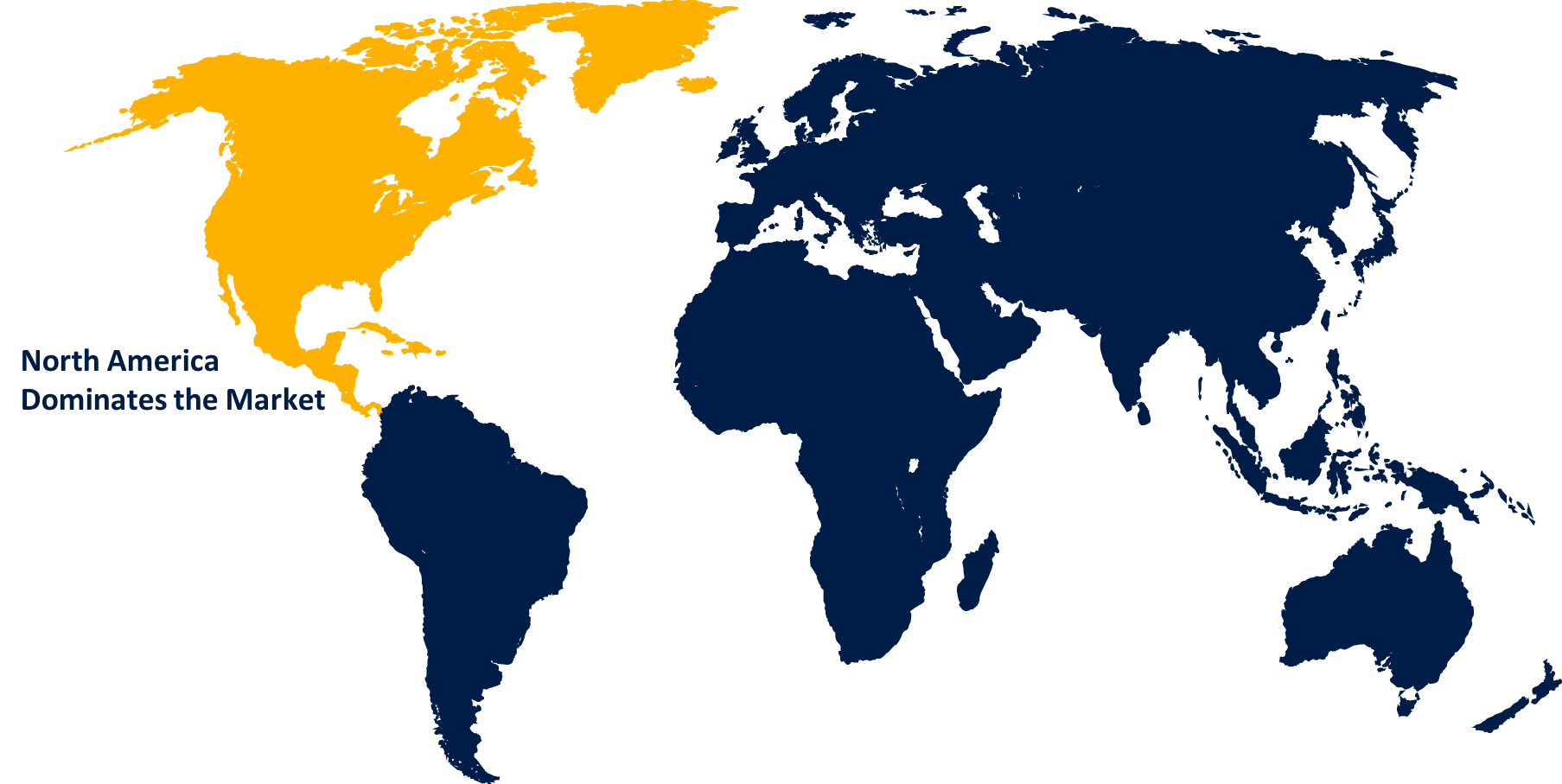Global Scaffold Technology Market Size, Share, and COVID-19 Impact Analysis, By Type (Hydrogels, Polymeric Scaffolds, Micropatterned Surface Microplates, and Nanofiber Based Scaffolds), By Disease Type (Orthopedics, Musculoskeletal, and Spine, Cancer, Skin and Integumentary, Dental, Cardiology and Vascular, Neurology, Urology, GI, Gynecology, and Others), By Application (Stem Cell Therapy, Regenerative Medicine, and Tissue Engineering, Drug Discovery, and Others), and By Region (North America, Europe, Asia-Pacific, Latin America, Middle East, and Africa), Analysis and Forecast 2023 - 2033
Industry: HealthcareGlobal Scaffold Technology Market Insights Forecasts to 2033
- The Global Scaffold Technology Market Size Was Valued at USD 1.99 Billion in 2023
- The Market Size is Growing at a CAGR of 14.16% from 2023 to 2033
- The Worldwide Scaffold Technology Market Size is Expected to Reach USD 7.48 Billion by 2033
- Asia Pacific is Expected to Grow the fastest during the forecast period.

Get more details on this report -
The Global Scaffold Technology Market Size is Anticipated to Exceed USD 7.48 Billion by 2033, Growing at a CAGR of 14.16% from 2023 to 2033.
Market Overview
Tissue engineering has a branch called scaffold technology. An extracellular substance that offers chemical, mechanical, and biological support is called a scaffold. During the formation of the new tissue, the material serves as a template. Because scaffold technologies are effective at simulating the in vivo physiological state for accurate representation of disease-causing microenvironmental factors, their applications in 3D cell cultures are expanding. As a result, 3D cell culture methods have become cutting-edge resources for early drug discovery and promising treatments for a range of illnesses. Many businesses are concentrating on expanding their product lines and creating new goods in order to provide a wide range of options in the scaffold technologies market. The advantage of replacing animal trials with real-time biological environment research and the snowballing effect of R&D efforts are the driving forces behind scaffold technology. Manufacturers are now incorporating 3D printing technology into the scaffold production process.
Report Coverage
This research report categorizes the market for the global scaffold technology based on various segments and regions forecasts revenue growth and analyzes trends in each submarket. The report analyses the key growth drivers, opportunities, and challenges influencing the global scaffold technology market. Recent market developments and competitive strategies such as expansion, product launch, and development, partnership, merger, and acquisition have been included to draw the competitive landscape in the market. The report strategically identifies and profiles the key market players and analyses their core competencies in each sub-segment of the global scaffold technology market.
Global Scaffold Technology Market Report Coverage
| Report Coverage | Details |
|---|---|
| Base Year: | 2023 |
| Market Size in 2023: | USD 1.99 Billion |
| Forecast Period: | 2023 - 2033 |
| Forecast Period CAGR 2023 - 2033 : | 14.16% |
| 2033 Value Projection: | USD 7.48 Billion |
| Historical Data for: | 2019-2022 |
| No. of Pages: | 180 |
| Tables, Charts & Figures: | 115 |
| Segments covered: | By Type, By Disease Type, By Application, By Region |
| Companies covered:: | Tempo Therapeutics, Inc., BIOTRONIK, Thermo Fisher Scientific, Inc., Merck KGaA, Tecan Trading AG, REPROCELL Inc., 3D Biotek LLC, Becton, Dickinson, and Company, Medtronic, Xanofi, Molecular Matrix, Inc., Matricel GmbH, Pelobiotech, 4titude, Corning Incorporated, and Others |
| Pitfalls & Challenges: | COVID-19 Empact, Challenge, Future, Growth, & Analysis |
Get more details on this report -
Driving Factors
Demand for novel nerve regeneration, orthopedic, and wound healing treatments.
The need for orthopedic, wound healing, and cutting-edge nerve regeneration solutions is driving the market's strong growth. Synthetic scaffolds are currently the industry leader due to their customized options and regulatory compliance. Additionally, due to their increased bioactivity, hybrid and in-situ forming scaffolds are gaining popularity. Technological developments in materials, like biomimetic materials, smart scaffolds, and 3D/4D printing, are essential for driving market expansion. The growing need for regenerative medicine is propelling the global scaffold technology market's notable expansion. The need for advanced treatment modalities is primarily driven by the aging population and the increasing prevalence of chronic diseases.
Restraining Factors
Government regulations are strict and the lengthy approval process
Obtaining regulatory clearance and protracted approval procedures add to the time and expense of launching new scaffold-based products.
Market Segmentation
The global scaffold technology market share is classified into type, disease type, and application.
- The hydrogels segment is expected to hold the largest share of the global scaffold technology market during the forecast period.
Based on the type, the global scaffold technology market is categorized into hydrogels, polymeric scaffolds, micropatterned surface microplates, and nanofiber-based scaffolds. Among these, the hydrogels segment is expected to hold the largest share of the global scaffold technology market during the forecast period. Technological developments in hydrogel microfabrication processes are expected to drive the segment's growth. Also, businesses are introducing novel hydrogels for drug depots, cell transplantation, and a barrier against restenosis.
- The orthopedics, musculoskeletal, & spine segment is expected to grow at the fastest CAGR during the forecast period.
Based on the disease type, the global scaffold technology market is categorized into orthopedics, musculoskeletal, & spine, cancer, skin and integumentary, dental, cardiology and vascular, neurology, urology, GI, gynecology, and others. Among these, the orthopedics, musculoskeletal, & spine segment is expected to grow at the fastest CAGR during the forecast period. Scaffold engineering uses a range of biomaterials; materials like silk fibroin are perfect for this application because of their remarkable cytocompatibility and slow biodegradability, which can increase demand and have a positive impact on segment growth.
- The stem cell therapy, regenerative medicine, & tissue engineering segment is expected to grow at the fastest CAGR during the forecast period.
Based on the application, the global scaffold technology market is categorized into stem cell therapy, regenerative medicine, & tissue engineering, drug discovery, and others. Among these, the stem cell therapy, regenerative medicine, & tissue engineering segment is expected to grow at the fastest CAGR during the forecast period. The reason behind this is the increasing use of scaffold technology in soft tissue, colorectal, tumor repair, aesthetic, and periodontal surgeries.
Regional Segment Analysis of the Global Scaffold Technology Market
- North America (U.S., Canada, Mexico)
- Europe (Germany, France, U.K., Italy, Spain, Rest of Europe)
- Asia-Pacific (China, Japan, India, Rest of APAC)
- South America (Brazil and the Rest of South America)
- The Middle East and Africa (UAE, South Africa, Rest of MEA)
North America is projected to hold the largest share of the global scaffold technology market over the forecast period.

Get more details on this report -
North America is projected to hold the largest share of the global scaffold technology market over the forecast period. This region's growth is fueled by the presence of notable players, The region's growth can be further attributed to the companies in this area launching novel and inventive products to aid in the development of scaffold technologies.
Asia Pacific is expected to grow at the fastest CAGR growth of the global scaffold technology market during the forecast period. The presence of government organizations engaged in stem cell and regenerative medicine research is responsible for the region's growth.
Competitive Analysis:
The report offers the appropriate analysis of the key organizations/companies involved within the global scaffold technology market along with a comparative evaluation primarily based on their product offering, business overviews, geographic presence, enterprise strategies, segment market share, and SWOT analysis. The report also provides an elaborative analysis focusing on the current news and developments of the companies, which includes product development, innovations, joint ventures, partnerships, mergers & acquisitions, strategic alliances, and others. This allows for the evaluation of the overall competition within the market.
List of Key Companies
- Tempo Therapeutics, Inc.
- BIOTRONIK
- Thermo Fisher Scientific, Inc.
- Merck KGaA
- Tecan Trading AG
- REPROCELL Inc.
- 3D Biotek LLC
- Becton, Dickinson, and Company
- Medtronic
- Xanofi
- Molecular Matrix, Inc.
- Matricel GmbH
- Pelobiotech
- 4titude
- Corning Incorporated
- Others
Key Market Developments
- In March 2024, Leading innovator in tissue engineering and regenerative medicine, Tempo Therapeutics, Inc., announced the successful conclusion of a USD 12 million Series A equity fundraising round. With the support of Tempo, the business will be able to advance its revolutionary Microporous-Annealed-Particle (MAP) technology platform and advance its candidates for synthetic tissue scaffolds into clinical trials.
- In February 2024, BIOTRONIK, a Leading international medical technology company announced that Freesolve Resorbable Magnesium Scaffold (RMS) has received CE approval and is available for purchase.
Key Target Audience
- Market Players
- Investors
- End-users
- Government Authorities
- Consulting And Research Firm
- Venture capitalists
- Value-Added Resellers (VARs)
Market Segment
This study forecasts revenue at global, regional, and country levels from 2020 to 2033. Spherical Insights has segmented the global scaffold technology market based on the below-mentioned segments:
Global Scaffold Technology Market, By Type
- Hydrogels
- Polymeric Scaffolds
- Micropatterned Surface Microplates
- Nanofiber Based Scaffolds
Global Scaffold Technology Market, By Disease Type
- Orthopedics, Musculoskeletal, & Spine
- Cancer
- Skin & Integumentary
- Dental
- Cardiology & Vascular
- Neurology
- Urology
- GI, Gynecology
- Others
Global Scaffold Technology Market, By Application
- Stem Cell Therapy, Regenerative Medicine, & Tissue Engineering
- Drug Discovery
- Others
Global Scaffold Technology Market, By Regional
- North America
- US
- Canada
- Mexico
- Europe
- Germany
- UK
- France
- Italy
- Spain
- Russia
- Rest of Europe
- Asia Pacific
- China
- Japan
- India
- South Korea
- Australia
- Rest of Asia Pacific
- South America
- Brazil
- Argentina
- Rest of South America
- Middle East & Africa
- UAE
- Saudi Arabia
- Qatar
- South Africa
- Rest of the Middle East & Africa
Frequently Asked Questions (FAQ)
-
1.What is the CAGR of the global scaffold technology market over the forecast period?The Global Scaffold Technology Market Size is Expected to Grow from USD 1.99 Billion in 2023 to USD 7.48 Billion by 2033, at a CAGR of 14.16% during the forecast period 2023-2033.
-
2.Which region is expected to hold the highest share in the global scaffold technology market?North America is projected to hold the largest share of the global scaffold technology market over the forecast period.
-
3.Who are the top key players in the scaffold technology market?The top key players in the global scaffold technology market are Tempo Therapeutics, Inc., BIOTRONIK, Thermo Fisher Scientific, Inc., Merck KGaA, Tecan Trading AG, REPROCELL Inc., 3D Biotek LLC, Becton, Dickinson, and Company, Medtronic, Xanofi, Molecular Matrix, Inc., Matricel GmbH, Pelobiotech, 4titude, Corning Incorporated, and Others.
Need help to buy this report?